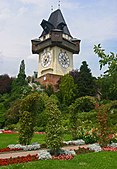Castle on the Graz Schloßberg
The castle on the Grazer Schloßberg was one of the most important fortifications in Styria and the main fortress of Graz . It was built on the Grazer Schloßberg and was first the seat of the sovereign when he stayed in Graz, and later his place of retreat in the event of attacks. The history of the hill fort goes back to the 12th century. The French destroyed the facility at the turn of the year 1809/10. Only the bell tower and clock tower are fully preserved today.
history
Originated in the 12th century
The keep was probably the first building and was built on the highest point of the castle hill. Over the following decades, a number of residential and farm buildings were built around it. In the 12th century, the city walls were connected to the castle. At the same time, the Graz clock tower was erected in front of the fortress and the St. Thomas Chapel was built . Work on the design of the castle has been ongoing since the 12th century. During the aristocratic revolt in 1292, the castle had proven to be an important base for the sovereign.
Extensions and modernizations
Under Emperor Friedrich III. the residence seat was moved to Graz Castle . The two castles were connected by a concealed passage. Especially between 1466 and 1486, the fortifications on the Schloßberg were further expanded, as it was a safe retreat in times of war. In 1480 the castle survived an attack by the Turks. Due to the increasing danger of Turkish attacks, the fortifications were expanded during the 15th century. In 1531 part of the mountain fortress was destroyed by three lightning strikes. On September 12, 1532, the Turkish army of Sultan Suleyman I passed Graz after an unsuccessful attack on the suburb, without attacking the castle itself. Around the same time it was criticized that the fortress no longer met the requirements of the time. In 1543 the modernization of the fortress began under the direction of the builder Domenico dell'Allio . Except for the chapel and a few remains of the wall, nothing remained of the old fortifications. At the place where the Schloßbergbahn is today, an elevator for material supply was built. The remainder of the material was carried up via the roads that are still preserved today with the help of wagons and pack animals, including elephants and camels from the spoils of war. The old keep was demolished and the construction of bastions began. The stable bastion is still preserved from the bastions. A cistern was built on the summit plateau after 25 meters had been removed. The 94-meter-deep Turkish well was dug at the stable bastion from April 2, 1554 to January 11, 1558. In 1561 the expansion and modernization of the fortress was largely completed. A native of the Middle Ages palace was demolished in 1577 and in its place soldiers houses were built. Due to a lack of money, however, this was not completed until 1608. In 1588 the bell tower was built, which is still preserved today. In 1683, due to the increasing danger of Turkish attacks, work was carried out again on the fortress after it had been neglected for almost 80 years.
Siege and destruction by the French
When the French occupied Graz in 1809, the genius colonel Franz Xaver Hackher zu Hart defended the Schlossberg. The French only succeeded in conquering the castle after the battle of Wagram through the conclusion of peace . At the turn of the year 1809/10 they destroyed all the facilities except for the bell and clock towers, which had been bought free by the people of Graz. In 1839 a park was built on the site of the destroyed fortifications.
Ownership and management
Until the 19th century, the castle was owned by the rulers and administered by a burgrave . The first burgrave is recorded for the year 1136. He came from a completely free family from the Trofaiach area . In 1167 his son or grandson took the place of burgrave. However, this was no longer highly free , but a princely ministerial . In 1189 there were two burgraves from different sexes. From 1229 small knight families served as burgraves. During the Hungarian rule, Count Amput sat in the castle. Since the reign of Ottokar II Přemysl , the provincial governors have been entrusted with the castle administration. Only during the reign of Emperor Friedrich III. and during the Hungarian occupation from 1480 to 1490 the burgraves were not dependent on the governor. In 1583 the dependency on the governor was completely dissolved and Hans Fernberger was appointed the first captain of the castle. He and his successors were dependent on the sovereign government. In addition to the office of castle captain, the office of burgrave existed until 1650, before it was abolished for cost reasons.
literature
- Robert Baravalle: Castles and palaces of Styria . Leykam, Graz 1995, ISBN 3-7011-7323-0 , p. 5–6 (first edition: 1961, reprint).
Coordinates: 47 ° 4 ′ 36.3 " N , 15 ° 26 ′ 14.2" E




